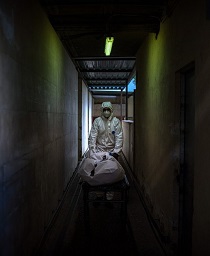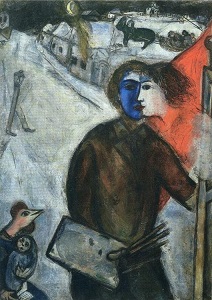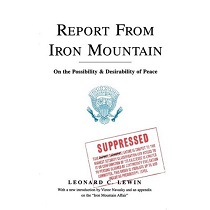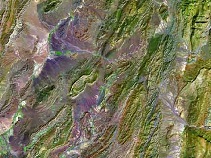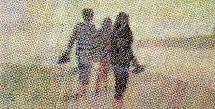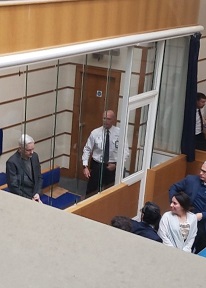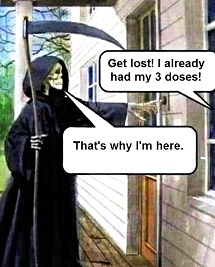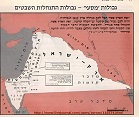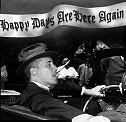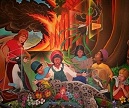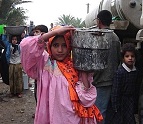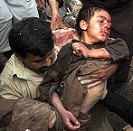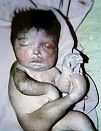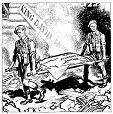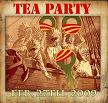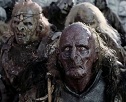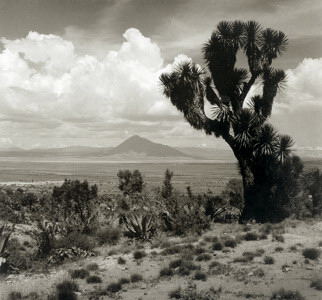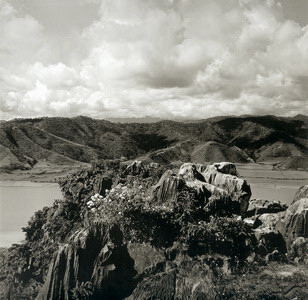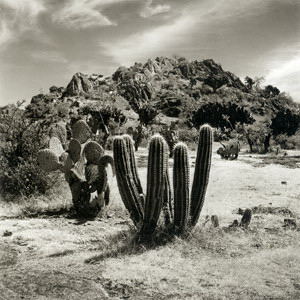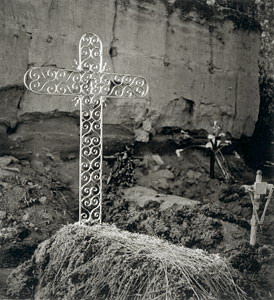Polvo eres. Fotografías de Juan Rulfo / Dust to dust. Photography by Juan Rulfo
Ergo Rodrerich
Polvo eres. Fotografías de Juan Rulfo
Enfoca
Se ha dicho repetidas veces que el genio de un artista no es un producto enteramente personal. Las llamadas influencias históricas o culturales se concretan en el sencillo espacio regional donde transcurre la vida del escritor, pintor, etcétera.
Juan Rulfo no escapa de esta aseveración y, más aún, se le ha tomado como ejemplo y como escuela (generando productos no siempre certeros). Los antecedentes de Rulfo nutren sus ambas obras: la literaria (multipremiada y reconocida) y la fotográfica (no del todo descubierta por las mayorías).
Es indudable que en Rulfo se alza constante y generadora la imagen de la tierra, así lo evidencian los nombres de algunos de sus cuentos: El llano en llamas (título de unos de sus libros), la Cuesta de las Comadres, Nos han dado la tierra, Luvina (nombre de un cerro), Paso del Norte.
Aunque el resto de sus cuentos, y de su fantasmal novela, Pedro Páramo, no porten títulos semejantes, sí hablan de un México rural que aparentemente dejó de serlo a partir de los años 50. Digo aparentemente porque a lo largo de todo el territorio nacional sigue existiendo un campesinado que se niega a desaparecer y que se muestra al mundo cotidianamente en el trabajo diario de la labor campesina rudimentaria y estalla multicolor en las fiestas religiosas de cada pueblo.
La fuente de nutrición para las imágenes rulfianas son sobre todo los paisajes secos, desnudos de verdor que podemos apreciar aún en el Sur de Jalisco. La región de Sayula (de donde erróneamente cree la mayoría que es Juan), junto con un puñados de pueblos (Amula, San Juan de Alima, Zapotitlán, Tuxcacuesco, región conocida como "El Bajo"), ejemplifican correctamente este paisaje peor para los ánimos que el desértico ya que las pocas plantas ahí existentes, secas y quebradizas, parecieran un símbolo de una constante muerte. Polvo que se levanta donde, en otras regiones, hay brisa; polvo que cala en los pulmones dejando profunda huella en los interiores del alma.
Rulfo respiró estos aires, pero no se quedó en el mero respiro ¿qué produjo al sentirse poseedor de una imagen que convertiría en propia?
Dispara
La tierra para el mexicano es auténticamente una madre, pero no sólo el origen de nuestra identidad, sino también de un destino inalterable. Repetidas veces he escuchado entre los míos, "aquí nací y aquí moriré".
Origen y meta, la circularidad de la Tierra deja de ser una obviedad geográfica para convertirse en un símbolo rector. Qué lejos estamos de los europeos y los argentinos que se han decidido a conquistar el mundo alejándose de su terruño original. El símbolo de la tierra como origen del mundo, visión mexicana, como lo estamos tratando aquí, nos viene de los pueblos prehispánicos. Observemos las pirámides y atendamos a su significado indígena. No es el "llegar al cielo" del mundo occidental con su ejemplo máximo, la Torre de Babel.
No, lejos de todo ello, la pirámide azteca y maya es un ascender la tierra, hacerla llegar a lo alto, como dando a conocer a los seres celestes cómo es el mundo terreno.
Revela
Rulfo es un excelente fotógrafo que obedece sus instintos y olvida las influencias de sus contemporáneos. Nadie más lejos que un Álvarez Bravo ya completamente citadino y hasta universal. Retraído (como nos lo ha descrito Juan José Arreola) parecería huir constantemente de la compañía de los demás.
La soledad pareciera la constante rulfiana (y eso rayaría en lo obvio ya que la mayoría de sus fotos son paisajes y éste puede muy bien omitir la figura humana. Sin embargo esto no es enteramente así, los atriles e instrumentos musicales de una banda musical acusan un gusto por la ausencia de la figura humana).
Dados estos antecedentes podríamos muy bien pensar que Rulfo no es un fotógrafo de lo humano, pero nada más alejado de la verdad. Él es un fotógrafo muy humano a la caza de imágenes plásticas.
Para entender esto hay que observar más de cerca y detenidamente. Partamos de lo mencionado anteriormente. El escritor jalisciense ha vivido su infancia entre cerros de arbustos estériles y remolinos de polvo, ha visto de cerca la desesperanza de dos guerras civiles (la Revolución Mexicana y la Guerra Cristera). Desde joven supo del abandono gubernamental lo cual tradujo, paisaje y sociedad, en desesperanzas existenciales (esos dos pilares que nos formaron como humanos, la naturaleza y la cultura, se le han venido abajo).
Hay en Rulfo, como una constante, sensualidad en las texturas y en la imagen lograda. El paisaje, para el indígena (he aquí otra de las herencias recibidas), alcanza sesgos de espiritualidad, todo tiene vida y alma. Por eso todo merece respeto y no es infrecuente encontrar al indígena pidiendo perdón por los daños que ocasionará al medio ambiente para lograr su subsistencia. Rulfo capta con su lente esa espiritualidad para, a través de la fotografía, alcanzar el simbolismo de una existencia jamás muerta.
El gran acierto de Rulfo como fotógrafo es haber transformado una imagen externa en un símbolo interno, de una desolación profunda del campesinado mexicano (que no fallaríamos en calificar de universal, tal ha calado en lo profundamente humano). Paisajes de una naturaleza muerta, sentimientos de percepción desencantada. Cielos sin nubes, futuros sin esperanza.
Cuidadoso observador de sus iguales y su desesperación, al menos nos ofrece la consolación de la belleza a través de la fotografía.
Ergo Rodrerich
2005, Zapotlán, El Grande, México
ergo_rodrerich@yahoo.com.mx
Fotografía
Rulfo: FOTÓGRAFO
Dan a conocer fotografías inéditas tomadas por Juan Rulfo
Juan Rulfo, escritor y fotógrafo: dos artes en conjunción
He aquí uno de los cuentos de Juan Rulfo (de “El Llano En Llamas”): "LUVINA"
__________________________________________________________________________________
Dust to dust. Photography by Juan Rulfo
Focus
It has been said many times that an artist's genius is not a wholly personal product. The so-called historical or cultural influences become a reality in the simple regional area where the life of the writer, painter, etc. transpires.
Juan Rulfo does not escape this assertion and even more so, he has been considered an example and school (creating products that were not always accurate). Rulfo's background feeds both of his areas of work: literature (he has won many prizes and is well acknowledged) and photography (not truly discovered by the majority).
Rulfo's work unquestionably contains constant uprisings and creates an image of the land, as confirmed by the titles of some of his tales: El llano en llamas (The burning plain), the title of one of his books, La Cuesta de las Comadres (The Comadres' hill), Nos han dado la tierra (They've given us the land), Luvina (the name of a hill) and Paso del Norte (The Northern flow).
Even though the rest of his tales and his ghostly novel, Pedro Páramo, do not have similar titles, they speak of a rural Mexico, which apparently stopped being rural from the 50s onwards. I say apparently because across Mexico there is a peasant population that does not disappear and which shows itself to the world on a daily basis through primitive agricultural work and the multicoloured explosions of these peoples at religious festivals in each of the villages.
Above all, Rulfo draws inspiration for his images from the dry landscapes that lack greenness and which we can still appreciate in the south of Jalisco. The region of Sayula (where the majority of people wrongly believe Juan is from), together with a handful of villages (Amula, San Juan de Alima, Zapotitlán, Tuxcacuesco, a region known as "El Bajo"), correctly illustrate this landscape, a landscape worse than the desert, given that the few plants that grow there are dry and brittle and appear to be a constant symbol of death. Dust swirls, whereas in other regions there is a breeze; dust that gets into your lungs, leaving a clear mark deep inside your soul.
Rulfo grew up in this environment, but he didn't just breathe the air; what did he produce when he felt himself to be the owner of an image that he would make his own?
Take
For Mexicans, the earth is truly a mother, but not only the origin of our identity, rather an unalterable destiny. Many times I have heard my family say "here I was born and here I'll die".
Origin and goal, the earth's circularity stops being a geographical certainty and becomes a guiding symbol. How distant we are from the Europeans and Argentineans, who have decided to conquer the world by leaving their home lands far behind. The symbol of the earth as the world's origin, the Mexican vision, the way we are dealing with it here, comes from the pre-Hispanic villages. Look at the pyramids and we pay attention to their native meaning. It is not the western idea of "reaching the heavens" with their greatest example being the Tower of Babel.
No, far from this idea, the Aztec and Mayan pyramid is a way of lifting up the earth as high as possible, as if we were showing the heavenly beings just how the earth is.
Develop
Rulfo is an excellent photographer, who obeys his instincts and forgets his contemporaries' influences. The complete opposite of an Álvarez Bravo, now totally urban and universal.
Withdrawn (as Juan José Arreola described him to us), he seemed to constantly run from the company of others. Solitude appears to be a constant Rulfo theme (and this verges on the obvious, as the majority of his photos are of landscapes and humans can therefore be easily omitted. It is not completely true however, as a band's music stands and musical instruments show an interest in the absence of the human figure).
Given this background, we could easily think that Rulfo does not do human photography, but this couldn't be further from the truth. He is a very human photographer in pursuit of plastic images.
In order to understand this, you need to look long and hard. We start with the aforementioned. The writer from Jalisco spent his childhood amongst the shrubs on the barren hillsides and the whirls of dust; he saw first hand the desperation of two civil wars (the Mexican Revolution and the Cristero (Catholic) Rebellion). From a young age he understood the lack of governmental presence, which he projected, landscape and society into existential despair (the two pillars that shape us as humans, nature and culture, had collapsed).
Sensuality is a constant theme in the textures and images achieved by Rulfo. For the natives, the landscape (another heritage received), has a spiritual slant, everything has a life and a soul. For this reason, everything deserves respect and it is not uncommon to find a native apologising for the harm he will do to the environment in order to survive. Rulfo catches this spirituality with his lens and through his photos he achieves the symbolism of an existence that never dies.
Rulfo's great skill as a photographer is to have transformed an external image into an internal symbol, the deep grief of the Mexican peasants we wouldn't be wrong to call it universal, considering how deeply he explored the human element). Landscapes portraying dead nature, feelings of disillusioned perception. Cloudless skies, hopeless futures.
A careful observer of his equals and their despair, at least he offers us the consolation of beauty through his photos.
Ergo Rodrerich
2005, Zapotlán, El Grande, México
ergo_rodrerich@yahoo.com.mx
Fotografía
Rulfo: FOTÓGRAFO
Dan a conocer fotografías inéditas tomadas por Juan Rulfo
Juan Rulfo, escritor y fotógrafo: dos artes en conjunción
Some readers may want to delve into one of Juan Rulfo's short stories (from “El Llano En Llamas”): "LUVINA"
__________________________________________________________________________________
Source:
http://www.elangelcaido.org/2005/11/200511jrulfo/200511jrulfo.html
http://www.elangelcaido.org/2005/11/200511jrulfo/200511jrulfoe.html

